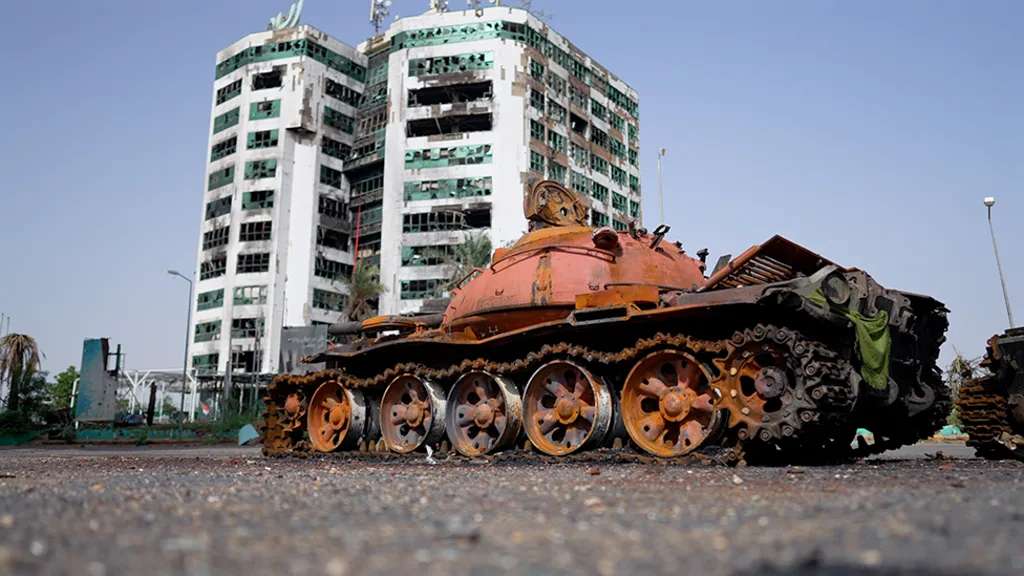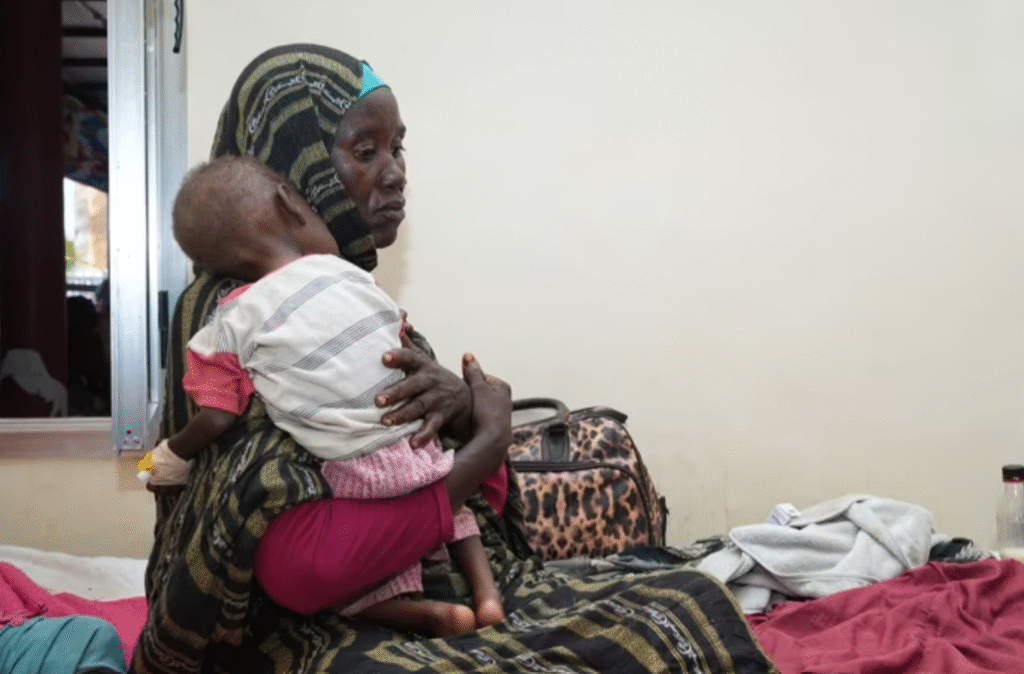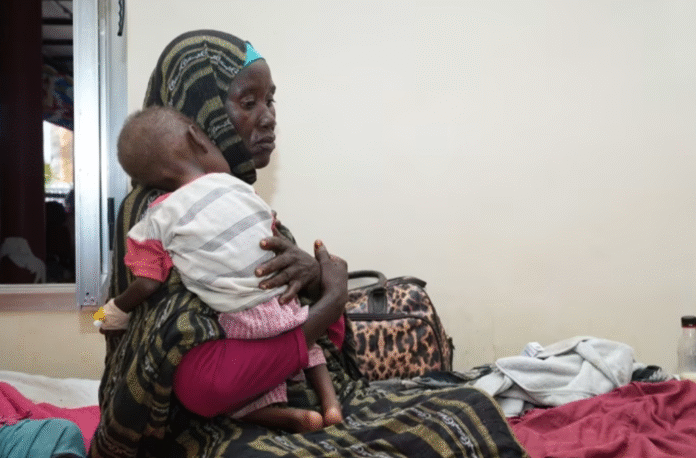Sudan War Child Crisis: A Mother’s Impossible Choice
The Sudan war child crisis has exposed unbearable human suffering, where mothers like Touma are forced to make choices no parent should ever face. Inside the malnutrition ward of Bashaer Hospital in Khartoum, Touma sits silently, holding her motionless three-year-old daughter, Masajed. Her eyes are blank, her body exhausted.
She hasn’t eaten in days. Around her, the cries of starving children echo through the ward — but her daughter no longer has the strength to cry. “I wish she would cry,” Touma whispers. “She hasn’t cried in days.”
Bashaer Hospital is one of the few facilities still operating in a city torn apart by war since April 2023. Families have walked for hours through danger zones to reach its gates, hoping to save their children from starvation.

Sudan War Child Crisis: The Price of Survival
In the chaos of Sudan’s ongoing civil war between the army and the Rapid Support Forces (RSF), thousands of families have lost everything, homes, livestock, and any sense of security. Touma’s family fled when fighters stormed her village, 200 kilometers southwest of Khartoum.
“The RSF took everything,” she says. “Our money, our animals, everything. We escaped with only our lives.”
But escaping the violence didn’t end their suffering. With no food and no income, her twin daughters grew weaker by the day. When they finally reached the hospital, doctors said both girls needed antibiotics immediately.
The family could only afford treatment for one child. Touma had to choose.
“I picked Manahil,” she says softly, tears welling. “I wish they could both live. I just wanted them to grow, walk, and play together again.”
Holding her dying daughter, she whispers, “I am alone. I have nothing. I have only God.”
A Nation in Collapse
Sudan’s conflict has triggered one of the world’s worst humanitarian disasters. The United Nations estimates that three million children under the age of five are acutely malnourished. Hospitals like Bashaer are overwhelmed, and while basic care is free, life-saving medicine must be paid for out-of-pocket.
For families like Touma’s, that cost is impossible to bear.
Doctors at the hospital quietly admit that most of the children in the ward will not survive. “The war took everything from them,” one nurse says. “They don’t even have a chance.”
The Human Toll: When Childhood Disappears
The Sudan war child crisis reaches far beyond hospital walls. Across Khartoum, remnants of the conflict lie scattered, burned tanks, broken buildings, and shattered dreams.
Twelve-year-old Zaher wheels himself through the rubble, his thin arms pushing a battered wheelchair past twisted metal and debris. “I’m coming home,” he sings softly. “Where’s my home?”
His voice, fragile yet determined, carries both grief and hope.
Zaher was once a boy who loved football and school. Then a drone strike hit while he was helping his mother sell lentils on the street. She remembers the moment vividly: “There was blood everywhere. I forced myself to stay awake because I knew if I fainted, he would die.”
Doctors couldn’t save Zaher’s legs. Both were amputated below the knee.
Sudan War Child Crisis: Dreams Lost, Hope Alive
Even through pain, Zaher dreams of playing football again. “I just want prosthetic legs,” he says. “So I can walk home and go to school.”
But prosthetics are far beyond his mother’s means. She looks at him with guilt and love. “He asks why I let them cut his legs,” she says, her voice breaking. “I couldn’t answer.”
Still, Zaher smiles when he talks about football. His favorite team? Real Madrid. His hero? Vinícius Jr. Even when playing on his knees in the dirt, surrounded by destruction, he refuses to give up the game he loves.
This is the soul of the Sudan war child crisis, a generation of children who have lost everything but still dream of something better.
Life in Ruins: The Story of Ahmed
In what used to be a bright playground in Khartoum, sixteen-year-old Ahmed now works clearing debris for $50 a month. The same place where he once laughed with his brothers is now a graveyard of broken swings, rusted rides, and shattered glass.
Ahmed wears a faded gray T-shirt with a smiley face, a cruel contrast to his reality. “We played here every day,” he says. “Now, I can’t believe it’s the same place.”
He’s found 15 human remains while working. “It’s terrifying,” he admits, holding up a bone. “This is a leg bone, like mine.”
Ahmed no longer dares to imagine the future. “When the war began, I knew I would die here,” he says. “So I stopped dreaming.”
The Classroom That Defied War
Despite the devastation, there are glimmers of hope. In a crumbling house in Khartoum, volunteers have created a makeshift school. Desks are old wooden planks. The roof leaks. But laughter fills the air.
Zaher and his friends attend this school, eager to learn. Their teacher, Miss Amal, has taught for 45 years. “I’ve never seen children so traumatized,” she says. “Their words, their play — everything is touched by violence.”
She explains that hunger is another battle. “Some students come from homes with no bread, no milk, no oil. Yet they come to class smiling.”
In this small classroom, the future of Sudan still flickers with light.

A Country of Broken Futures
Across Sudan, millions of children like Zaher, Ahmed, and Manahil face the same grim reality. Schools have been destroyed. Hospitals are in ruins. Families are separated, and hunger is constant.
Still, amid chaos, these children show extraordinary courage. Their laughter, their games, even their songs echo through the ruins like a quiet form of resistance.
As Zaher says while dragging himself across a torn football pitch: “We shouldn’t be afraid of bombs. We should be brave.”
His words capture the spirit of a generation that refuses to be silenced by war.
Conclusion: Humanity in the Darkest Times
The Sudan war child crisis is not just a story of suffering, it’s a cry for help and a testament to endurance. From mothers making impossible choices to children clinging to hope, Sudan’s people are showing the world what resilience looks like.
They deserve more than sympathy, they deserve action.
Until peace returns, their voices will remain the heartbeat of a country fighting to survive, one child at a time.

